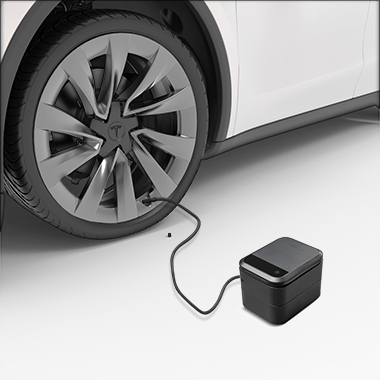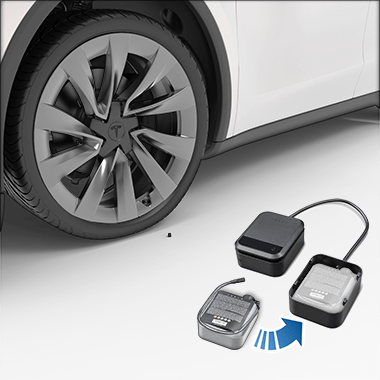Temporary Tire Repair Kit
THIS VEHICLE DOES NOT HAVE A SPARE WHEEL, BECAUSE IT HAS THE "FIX & GO" SYSTEM AS AN ALTERNATIVE SYSTEM, WHICH MUST BE USED WITH THE ACCOMPANYING INSTRUCTIONS FOR USE.
Warning
- Do not drive on a deflated tire.
- Do not remove any foreign objects found embedded in the tire.
- Do not leave the compressor on for over 20 consecutive minutes.
- Do not drive at high speeds or long periods of time. The temporary repair is designed to get your vehicle immediately and safely to a tire repair shop. Driving on temporarily repaired tires for long periods of time may cause serious damage or injury.
CAUTION
Follow all directions
and warnings on the tire inflation kit.
Tire Repair
The tire inflation kit is a temporary repair only. You must repair or replace a damaged tire as soon as possible. For punctures larger than 1/4” (6 mm), severe tread damage, a damaged sidewall, ripped tires or tires that have come off the rim, contact Roadside Assistance. To temporarily repair a tire:
- Park your vehicle in a safe, open location.
- Ensure the compressor is Off.
- Remove the punctured tire valve
cap on the vehicle and connect the transparent sealant tube to the valve opening.

- Insert the electrical plug into one of the vehicle's low voltage sockets.
- Turn the selector switch to the
tire icon and turn On. Once the sealant has properly flowed into the tire, the
gauge shows the current tire pressure. The ideal pressure is indicated on the
driver's side door pillar of the vehicle. After several minutes, ensure the
gauge shows the ideal tire pressure before continuing.NoteIf the gauge still indicates a pressure of less than 22 PSI (1.5 Bar) after 15 minutes of consecutive operation, disconnect the transparent sealant tube and screw the tire valve cap back on. Drive for a few feet (meters) to allow the sealant to distribute within the tire. Park Model Y and re-try steps 2-5. If this still does not work, call Tesla Roadside Assistance.
- Turn the kit Off and disconnect the tube from the tire. Screw the tire valve cap back on.
- Drive within the indicated speed
limit (shown on sticker on the tire repair kit) without suddenly accelerating or
braking. After approximately 10 minutes of driving, park in a safe, open space
again. Proceed to inflate the tire(s) now that the sealant has been distributed
in the tire.WarningThe sealant liquid is efficient at temperatures between -40°F (-40°C) and 122° F (50°C). Do not use sealant liquid after the expiration date indicated on the label. See Canister Replacement for more information on replacing a used or expired canister.
Tire Inflation
- Make sure tire compressor is Off.
- Turn the switch to the pump icon.
- Insert the electrical plug into one of the vehicle's low voltage sockets.
- Remove the tire valve cap and
connect the black inflation tube to the valve opening.

- Turn the compressor On until it reaches the ideal pressure indicated on the driver's side door pillar of the vehicle.
- Remove the black inflation tube and replace the tire valve cap.
- Turn the compressor Off and store in a safe, dry place.
Canister Replacement
- Purchase refills from the manufacturer or online from https://shop.tesla.com/.
- Remove the used canister by taking out the transparent sealant tube and setting it aside.
- Press the red release button while lifting out the canister.
- Insert the new canister by
pressing it firmly into the case. Re-attach the transparent sealant tube. Take
note of the new canister’s expiration date.

- Dispose of the empty canister properly according to local regulations.